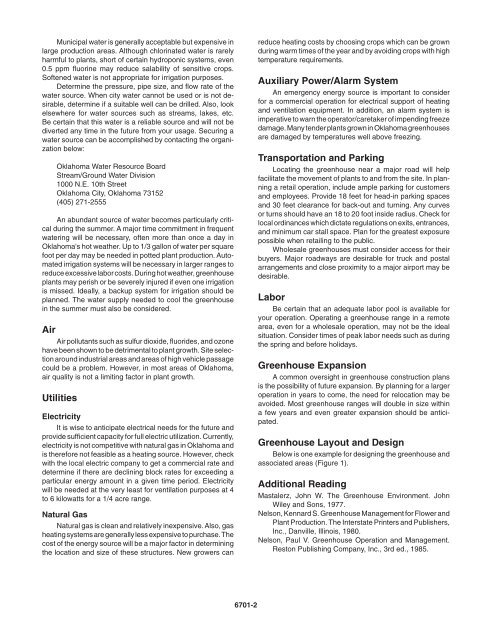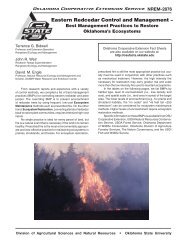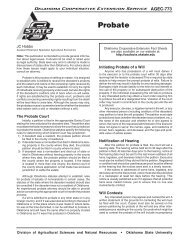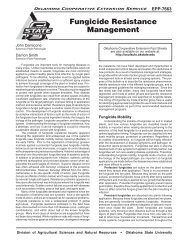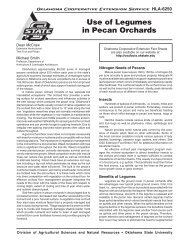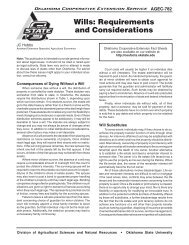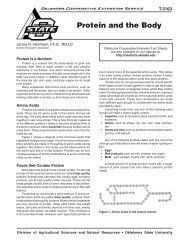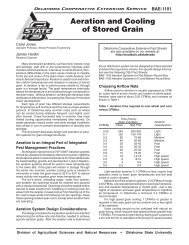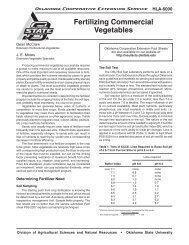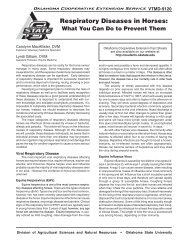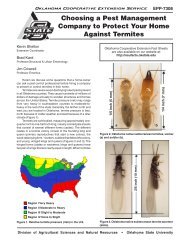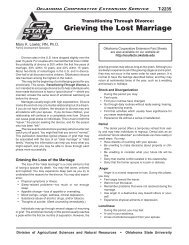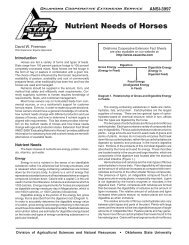Locating the Greenhouse - OSU Fact Sheets - Oklahoma State ...
Locating the Greenhouse - OSU Fact Sheets - Oklahoma State ...
Locating the Greenhouse - OSU Fact Sheets - Oklahoma State ...
You also want an ePaper? Increase the reach of your titles
YUMPU automatically turns print PDFs into web optimized ePapers that Google loves.
Municipal water is generally acceptable but expensive in<br />
large production areas. Although chlorinated water is rarely<br />
harmful to plants, short of certain hydroponic systems, even<br />
0.5 ppm fluorine may reduce salability of sensitive crops.<br />
Softened water is not appropriate for irrigation purposes.<br />
Determine <strong>the</strong> pressure, pipe size, and flow rate of <strong>the</strong><br />
water source. When city water cannot be used or is not desirable,<br />
determine if a suitable well can be drilled. Also, look<br />
elsewhere for water sources such as streams, lakes, etc.<br />
Be certain that this water is a reliable source and will not be<br />
diverted any time in <strong>the</strong> future from your usage. Securing a<br />
water source can be accomplished by contacting <strong>the</strong> organization<br />
below:<br />
<strong>Oklahoma</strong> Water Resource Board<br />
Stream/Ground Water Division<br />
1000 N.E. 10th Street<br />
<strong>Oklahoma</strong> City, <strong>Oklahoma</strong> 73152<br />
(405) 271-2555<br />
An abundant source of water becomes particularly critical<br />
during <strong>the</strong> summer. A major time commitment in frequent<br />
watering will be necessary, often more than once a day in<br />
<strong>Oklahoma</strong>'s hot wea<strong>the</strong>r. Up to 1/3 gallon of water per square<br />
foot per day may be needed in potted plant production. Automated<br />
irrigation systems will be necessary in larger ranges to<br />
reduce excessive labor costs. During hot wea<strong>the</strong>r, greenhouse<br />
plants may perish or be severely injured if even one irrigation<br />
is missed. Ideally, a backup system for irrigation should be<br />
planned. The water supply needed to cool <strong>the</strong> greenhouse<br />
in <strong>the</strong> summer must also be considered.<br />
Air<br />
Air pollutants such as sulfur dioxide, fluorides, and ozone<br />
have been shown to be detrimental to plant growth. Site selection<br />
around industrial areas and areas of high vehicle passage<br />
could be a problem. However, in most areas of <strong>Oklahoma</strong>,<br />
air quality is not a limiting factor in plant growth.<br />
Utilities<br />
Electricity<br />
It is wise to anticipate electrical needs for <strong>the</strong> future and<br />
provide sufficient capacity for full electric utilization. Currently,<br />
electricity is not competitive with natural gas in <strong>Oklahoma</strong> and<br />
is <strong>the</strong>refore not feasible as a heating source. However, check<br />
with <strong>the</strong> local electric company to get a commercial rate and<br />
determine if <strong>the</strong>re are declining block rates for exceeding a<br />
particular energy amount in a given time period. Electricity<br />
will be needed at <strong>the</strong> very least for ventilation purposes at 4<br />
to 6 kilowatts for a 1/4 acre range.<br />
Natural Gas<br />
Natural gas is clean and relatively inexpensive. Also, gas<br />
heating systems are generally less expensive to purchase. The<br />
cost of <strong>the</strong> energy source will be a major factor in determining<br />
<strong>the</strong> location and size of <strong>the</strong>se structures. New growers can<br />
reduce heating costs by choosing crops which can be grown<br />
during warm times of <strong>the</strong> year and by avoiding crops with high<br />
temperature requirements.<br />
Auxiliary Power/Alarm System<br />
An emergency energy source is important to consider<br />
for a commercial operation for electrical support of heating<br />
and ventilation equipment. In addition, an alarm system is<br />
imperative to warn <strong>the</strong> operator/caretaker of impending freeze<br />
damage. Many tender plants grown in <strong>Oklahoma</strong> greenhouses<br />
are damaged by temperatures well above freezing.<br />
Transportation and Parking<br />
<strong>Locating</strong> <strong>the</strong> greenhouse near a major road will help<br />
facilitate <strong>the</strong> movement of plants to and from <strong>the</strong> site. In planning<br />
a retail operation, include ample parking for customers<br />
and employees. Provide 18 feet for head-in parking spaces<br />
and 30 feet clearance for back-out and turning. Any curves<br />
or turns should have an 18 to 20 foot inside radius. Check for<br />
local ordinances which dictate regulations on exits, entrances,<br />
and minimum car stall space. Plan for <strong>the</strong> greatest exposure<br />
possible when retailing to <strong>the</strong> public.<br />
Wholesale greenhouses must consider access for <strong>the</strong>ir<br />
buyers. Major roadways are desirable for truck and postal<br />
arrangements and close proximity to a major airport may be<br />
desirable.<br />
Labor<br />
Be certain that an adequate labor pool is available for<br />
your operation. Operating a greenhouse range in a remote<br />
area, even for a wholesale operation, may not be <strong>the</strong> ideal<br />
situation. Consider times of peak labor needs such as during<br />
<strong>the</strong> spring and before holidays.<br />
<strong>Greenhouse</strong> Expansion<br />
A common oversight in greenhouse construction plans<br />
is <strong>the</strong> possibility of future expansion. By planning for a larger<br />
operation in years to come, <strong>the</strong> need for relocation may be<br />
avoided. Most greenhouse ranges will double in size within<br />
a few years and even greater expansion should be anticipated.<br />
<strong>Greenhouse</strong> Layout and Design<br />
Below is one example for designing <strong>the</strong> greenhouse and<br />
associated areas (Figure 1).<br />
Additional Reading<br />
Mastalerz, John W. The <strong>Greenhouse</strong> Environment. John<br />
Wiley and Sons, 1977.<br />
Nelson, Kennard S. <strong>Greenhouse</strong> Management for Flower and<br />
Plant Production. The Interstate Printers and Publishers,<br />
Inc., Danville, Illinois, 1980.<br />
Nelson, Paul V. <strong>Greenhouse</strong> Operation and Management.<br />
Reston Publishing Company, Inc., 3rd ed., 1985.<br />
6701-2


